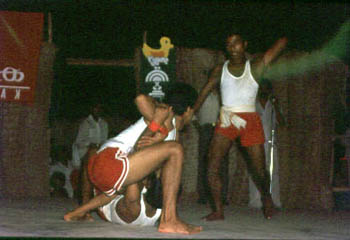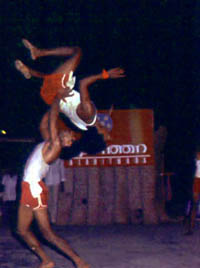|
The ABC of Kalarippayattu: An ancient martial art of Kerala
Remember
the legendary Bruce Lee in Enter the Dragon? Martial
arts thrived in the ancient Orient.
While
Japan and China had their judo, kung fu, karate, jiu
jit su etc, India had in its southern coastal strip
of Kerala, from very early period, a warfare system
known as kalarippayattu. History has that the art form
was taken to the east and the far east Asia by the Buddhist
monks who once upon a time, say, a couple of thousand
years ago, roamed around this part of the country.
 In those days the term `kalari' meant a gymnastic school.
Later on it came to mean simply a nursery school under
a guru/master, where the alphabet and numbers were taught
to the tiny-tots. Today even that is extinct with the
advent of modern education. And the term `payattu' meant
gymnastic combat. Today there is a concerted attempt
to revive the good old fighting system.
The practice had similarities with south Karnataka's Garadu and Sri Lanka's Kandyan Haramba Salawa. In Kerala it
was an integral part of the social and political system
of the medieval period. However, there was no region
then demarcated as Kerala. Instead, there were principalities
and fiefdoms or nadus and desams. Fightings were frequent.
Each principality used to keep its own army of trained
fighters. Certain families used to be skilled in the
art traditionally as a matter of social prestige.
 In the custom of angam or single combat also professional fighters were required. In angam, any individual or family dispute used to be settled by engaging a professional fighter by each side and the winning side would be declared
as having won in the dispute. This was a source of income
for the fighter, by way of fee, as well as for the political
authority, accruing in the form of levy from the disputing
parties. A majority of the fighters belonged to the
Nair community. Medieval ballads describe how even women
emerged as ferocious fighters learned in the techniques
of kalarippayattu.
With the advent of the British East India Company in the
early 19th century, the system began to decay and disappear.
The colonisers wanted to destroy the martial character
of the community, especially in the northern parts,
then called as Malabar. Folk stories and ballads and
technical treatises of those days throw light on the
nuances of the techniques and practice of the warfare.
The
kalari's ground structure was described as of several
types such as aimpatheerati (52 feet), nalpatheerati
(42 feet), muppatheerati (32 feet), pathinetteerati
(18 feet) and pantheerati (12 feet). The most common
among them was the nalpatheerati (42 feet). All types
had a width of half their length, except Pantheerati,
which was a square.
From
under the structure the ground was dug and a pit was
created of, say, six feet depth. Various spots around
the structure were dedicated to various gods and goddesses
and the preceptor. There was a metaphysical belief that
a structure of the kalari represented the universe.
The basis of the training was physical exercises and
discipline. At seven years of age, a student joined
the gurukul. The uzhichil or oil massage was an essential
part of the training. Each combination of steps learned
was called an adavu. The training started in the morning
wearing kacha, a cloth six feet in length and one foot
in width wound around the waist. A belt was also tightened
around that.
After
the physical training, the students were taught how
to use weapons. Cheruvati was a small stick about 22
inches in length to give blows and to resist blows.
Kathi (dagger), sword, kuntham (spear) and urumi were
metallic weapons. The practice of kalarippayattu declined
over the centuries but it gave shape to the later forms
of classical dances such as Kathakali, Kutiyaattam,
Theyyam etc. -RM Nair
|